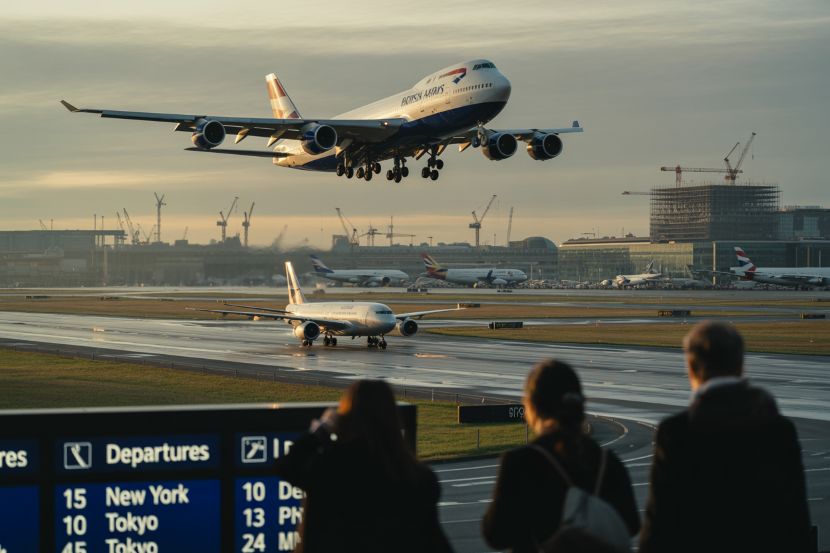Published on
October 7, 2025
Visitors and business travellers to the United Kingdom are being urged to plan smarter as ministers advance multiple airport expansion schemes while the country runs a sizeable tourism spending gap. For people flying into London for meetings or sightseeing, the debate is not academic: it affects fares, airport congestion, and whether domestic alternatives might be the better value this season.
What changed: a wave of approvals and invitations
Since 2024, the government has approved capacity growth at London City Airport and granted development consent for London Luton Airport and Gatwick’s Northern Runway. In January 2025, ministers also invited Heathrow to bring forward proposals for a third runway. Together, these decisions signal a clear policy tilt to add air capacity around the capital.
The numbers: a tourism deficit that dwarfs inbound earnings
Official data show UK residents spent £78.6bn on trips abroad in 2024, while overseas visitors spent £32.5bn in the UK—leaving a ~£46bn gap. Parliamentary analysis places the 2024 current account deficit at £63bn; the tourism gap therefore made up a very large share of that total. For travellers, this helps explain why more outbound leisure flying does not automatically translate into stronger local visitor economies.
Is growth really about business travel?
Policy justifications often highlight productivity and corporate connectivity. Yet independent assessments indicate business-purpose flying has not recovered to historic highs, with leisure flows driving most growth. The Climate Change Committee (CCC) also advised that aviation’s path to net zero will likely involve higher effective ticket prices as decarbonisation costs are reflected in fares—meaning short-term fare cuts from added capacity may be offset by climate policy over time.
Who benefits most from extra capacity?
Research suggests flying is highly concentrated: around 15% of people take about 70% of flights, and a growing ultra-frequent flyer group (roughly 3% of the population) takes six or more trips a year, mainly for leisure. If expansion primarily serves very frequent travellers, wider local benefits may be limited unless policy also directs spend towards domestic destinations.
Ownership and finance context
Control of major airports is increasingly international. Gatwick’s majority owner is France-based VINCI Airports, while Heathrow’s shareholding now includes Ardian and Saudi Arabia’s Public Investment Fund, alongside the Qatar Investment Authority. This mix underlines how the UK often finances external deficits through inward investment and asset sales—a point long noted by the Bank of England.
What it means today for tourists and business travellers
For leisure visitors, more flights can widen choice and sometimes lower near-term fares; for business travellers, additional frequencies can improve same-day options. But with climate policy likely to raise effective costs over time and a tourism deficit diverting spend abroad, travellers may find domestic or rail-first options increasingly attractive for price, comfort, and carbon reasons—especially on short-haul.
Quick tips: make your UK trip smoother (and better value)Compare airports and rail: On London–UK regional routes under 4 hours by train, check rail against air for total journey time, comfort, and city-centre arrival.Book flexible fares: If flying into London, mix-and-match airports (arrive Heathrow, depart City) to hedge against disruptions and strike better times.Leverage capping and passes: In London, contactless daily caps help manage costs; on intercity routes, advance rail fares can undercut short-haul flights during peaks.Plan for carbon: Expect aviation to price in more decarbonisation costs this decade; early booking and off-peak travel can help offset volatility.Step-by-step guidelines for travellersCheck policy-driven changes: Before booking, scan GOV.UK or airport pages for expansion works that might affect terminals, transport links or flight times.Price the whole journey: Add airport transfers and time to security when comparing air vs rail; many UK city pairs are faster door-to-door by train.Choose resilient routings: If tight for time, prefer Heathrow or Gatwick for long-haul connectivity; use City for central-London access; Luton/Stansted for point-to-point leisure.Protect schedules: For meetings, build 90–120 minutes of buffer on arrival days, reflecting current capacity changes and seasonal weather variability.Support local tourism: If adding leisure days, consider UK coastal and heritage towns—spend stays in-country to balance costs while discovering new places.Watch fares into 2026: Track fare trends as sustainable fuels, offsets and ETS adjustments evolve; set alerts and book early for peak weeks.Additional context for decision-makers and travellersGatwick Northern Runway consent was granted in September 2025 after a lengthy examination under the Planning Act 2008.Luton Expansion received a Development Consent Order in April 2025.London City capacity uplift was allowed on appeal in August 2024, while keeping the Saturday afternoon pause.Heathrow has been invited to submit third-runway proposals, with ministers signalling support subject to statutory tests.Key points (for speed readers)Airport growth: Approvals at Gatwick, Luton and London City; Heathrow proposal invited.Tourism gap: UK outbound spend (£78.6bn) far exceeds inbound (£32.5bn) → ~£46bn deficit.Macro link: The £46bn gap sat alongside a £63bn 2024 current account deficit.Who flies most: A small group takes a large share of flights; ultra-frequent leisure travel is rising.Future fares: CCC expects decarbonisation to flow through to ticket prices over time.
